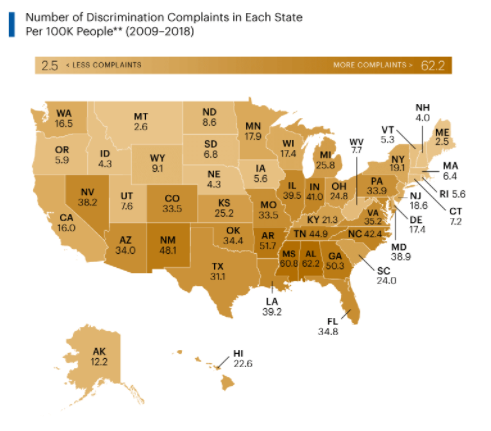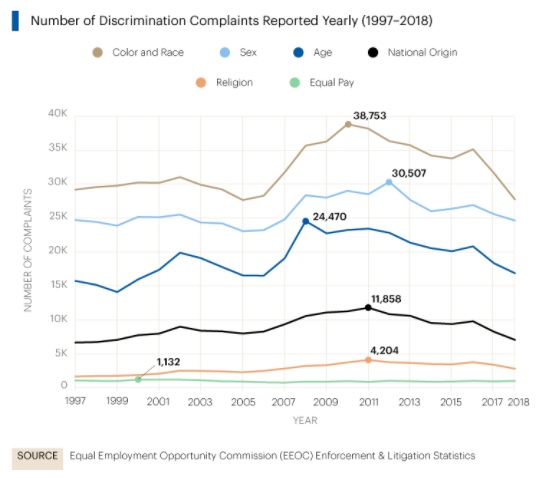Even though discrimination in the work context is illegal, it still maintains to exist withinside the place of the job. Racial discrepancies in employment results are fueled in part by structural racism’s legacy effects, as well as current systems and activities, such as willful discrimination, unconscious bias, systematic practices, and structural impediments. The Equal Employment Opportunity Commission (EEOC) obtained 89,385 expenses of discrimination withinside the place of job in 2015 (U.S. EEOC). At the very least, those figures display that a large number of Americans are nevertheless subjected to discriminatory practices that obstruct their capacity to interact withinside the group of workers. Discrimination based on race and ethnicity creates many disparities and violates the rights of individuals.
According to the U.S. EEOC, there were 1,889,631 discrimination complaints filed with the EEOC between 1997 and 2018. In 2017, 34 percent of these complaints were connected to race discrimination (U.S. EEOC). Between 2009 and 2018, the EEOC received 916,623 discrimination complaints (U.S. EEOC). Figure 1 illustrates the number of discrimination complaints by states

Between 1997 and 2018, the EEOC received approximately 710,500 discrimination complaints under one category: race and color (U.S. EEOC). It is seen from figure 2 that while the total number of complaints decreased marginally from 2002 to 2005, there was a sharp increase in claims of color and race discrimination in 2006, which continued to rise through 2010 (U.S. EEOC). Color and racial discrimination allegations continue to outnumber all other categories of complaints.

Furthermore, Black graduates from premier colleges are more likely than White graduates to be offered positions with lower income and status. One of the consequences of discrimination is that it can stifle career advancement and leadership changes for employees. Discrimination can also jeopardize the employment experience, posing a threat to the success of the particular organization’s performance (Small & Pager, 2020). When African Americans’ capacity to engage fairly and completely in the workplace is harmed by discrimination, it has a detrimental impact on their families, communities, and society as a whole (Jemal et al., 2019). However, African Americans are disadvantaged much more when they are unable to enter the workforce due to preconceptions that prevent them from applying. African Americans continue to face disproportionate impediments to work, ranging from historical forms of discrimination based on race and ability to modern kinds of discrimination based on first names and employer bias.
The main cause of racial discrimination at the workplace is employer bias. Despite efforts to create diverse workplaces, the biases of people in charge of employment decisions frequently thwart these good intentions. Too often, these gatekeepers’ limited life experiences impact their decisions regarding job applicants, who are subsequently included or rejected based on those decisions (Small & Pager, 2020). Employers may intuitively want to be surrounded by people with whom they share a common interest while rejecting those who make them uncomfortable.
People’s unconscious prejudices cause them to evaluate applicants’ qualifications differently, even when the attribute is the same. Complex prejudice is the outcome of numerous overlapping demographic traits, such as race, class, gender, and ability, rather than a single factor (Small & Pager, 2020). Many people argue that these multiple types of discrimination refute the idea of unconscious bias, arguing that discrimination is neither subtle nor unconscious. This form of bias, which stems from a long history of unfavorable stereotypes about certain groups, is becoming a more common basis for discrimination claims, but it is tough to prove.
It is not difficult to claim that today’s workplace discrimination has its roots in the legacy of slavery and colonialism. Various state policies and practices in the U.S. have been motivated by racism. They are slavery, job discrimination, segregation, and denial of voting rights. Until the Civil War in 1865, slavery was practiced predominantly in the southern areas of the U.S. In 1964, job discrimination, or the exclusion of persons from jobs because of their race, was made illegal on a nationwide level. In 1964, segregation in the workplace, schools, and other public areas became illegal. Many localities (particularly in the South) made it difficult for black people to vote after the Civil War by implementing “literacy tests” and other barriers. This was also made illegal in 1964 and again in 1965 with the passage of the Voting Rights Act.
Institutional factors can also have an impact on current discrimination as a result of past discrimination. Some forms of discrimination were so common in the past that they resulted in significant inequalities between racial groups, the effects of which can still be seen today. Furthermore, because many types of discrimination in the past were institutional in nature, their ramifications can still be seen in current organizational practices or regulations. As a result, even if all kinds of discrimination, whether individual or institutional, taste-based or statistical, were vanished, there would still be a variety of reasons to investigate prejudice in the past in order to comprehend the present. This is a difficult and broad topic that contains a lot of studies done by historians rather than sociologists.
Job gaps and unemployment periods can also affect the competitiveness of African Americans in the labor market. During the economic crisis of the last decade, many companies have sought the best outlook among the companies already employed and overlooked the unemployed. The Equal Employment Opportunity Commission (EEOC) is concerned that this type of discrimination will have a disproportionate impact on protected groups, especially African Americans. If people are unable to get a job due to a lack of work, the opportunity to gain a foothold in the labor market is limited.
Discrimination has been linked to a variety of health problems in African Americans, including hypertension, depression, anxiety, sleep disruptions, exhaustion, and physical discomfort (Jemal et al., 2019). Employees’ motivation, devotion to their tasks, and involvement are all drained by racial prejudice in the workplace. Those who experience job discrimination, for example, are less likely to strongly agree that they have the freedom to do what they do best, that their opinions matter, or that someone cares about them as a person (Jemal et al., 2019). Employees who have experienced prejudice are far more likely to be attrition risks — whether actively looking for another job or keeping an eye out for opportunities — than those who have not experienced discrimination (Jemal et al., 2019).
As difficult as it may appear, the issue of workplace racism may be effectively tackled with the correct information, incentives, and investment. Although business leaders may not be able to change the world, they can surely transform the organizational environment. Organizations are tiny, independent entities that provide leaders a lot of control over cultural norms and procedural regulations, making them excellent sites to implement racial fairness policies and practices.
One of the potential strategies to combat discrimination at the workplace is to educate the workers about discrimination. Employers are required by some state regulations to conduct anti-discrimination training on a regular basis. It is critical to make sure that all employees are informed of potential workplace discrimination issues, as well as your policies and processes and how to report an allegation. It is possible to provide separate training for supervisors and managers because they are your first line of defense in combating workplace discrimination. It is essential to inform employees about the potential consequences of discrimination, such as lawsuits.
Face-to-face training, internal messaging, or even deploying visual aids in common locations to promote anti discriminatory practices are just a few ways to keep everyone informed and up to date about the issue (Whitaker, 2020). Unconscious bias awareness training is the first step toward eliminating it in the workplace, as it enables employees to know that everyone has it and to recognize their own.
Another strategy to combat racial discrimination at the workplace is to conduct team-building activities. Holding team-building exercises and events in addition to training in a meeting set helps to assist the staff in communicating and understanding one other better. Employees from different backgrounds might be encouraged to share their cultural and ethnic information in a variety of interactive ways. Such team-building activities are a great opportunity to promote diversity and inclusion.
According to Livingston (2020), in order for the organization to overcome racial discrimination at the workplace, several stages should be implemented. These stages are illustrated in figure 3, and they are concerned with raising the problem awareness, analyzing the root cause, improving an empathy or level of the concern, providing strategies that address the problem, and willingness to implement the strategy.

References
Jemal, A., Gardiner, M., & Bloeser, K. (2019). Perceived race as variable: moderating relationship between perceived discrimination in the workplace and mentally unhealthy days. Journal of Racial and Ethnic Health Disparities, 6(2), 265-272. Web.
Livingston, R. 2020. How to promote racial equity in the workplace. Harvard Business Review. Web.
Small, M. L., & Pager, D. (2020). Sociological perspectives on racial discrimination. Journal of Economic Perspectives, 34(2), 49-67. Web.
U.S. EEOC. EEOC releases fiscal year 2020 enforcement and litigation data. Web.
Whitaker, T. R. (2019). Banging on a locked door: The persistent role of racial discrimination in the workplace. Social Work in Public Health, 1–6. Web.